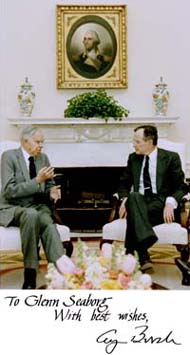 |
Meet Glenn Seaborg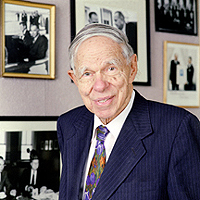
He won a Nobel Prize before he was 40. Nine presidents sought his advice. He discovered the element that makes atomic bombs explode. And he discovered radioisotopes used to treat millions of cancer patients. His accomplishments include:
These are just the highlights - Glenn T. Seaborg is in the Guinness Book of World Records for having the longest entry in “Who’s Who in America.” His high profile career has led him to the forefront of many prominent scientific organizations, including serving as president of both the 138,000-member American Association for the Advancement of Science and the 150,000-member American Chemical Society. His fame is international. The academies of sciences of eight foreign countries have elected him an honorary member. He’s been something of a folk hero in his ancestral Sweden from the time he responded to the king’s Nobel Prize toast in the distinctive Swedish dialect of his mother’s region. His work reveals the excitement of scientific discovery - and a look into the mysterious world of nuclear science. It opens a window onto the corridors of power - from an “unsophisticated” scientist who survived 10 years in the Washington jungle, and left it on his own terms. This website introduces you to Glenn Seaborg the scientist, statesman, and educator. Through it, you will encounter famous personalities, steal a behind-the-scenes glimpse of national politics, and learn some science. If you are still curious, look for the comprehensive autobiography of Glenn Seaborg to be published soon by Farrar, Strauss & Giroux. |
|
|
Seaborg by Seaborg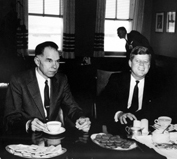 When the phone rang in the Radiation Laboratory one January afternoon I recognized the Boston accent from the newscasts. President-elect John F. Kennedy wanted to know: Would I join his administration as head of the Atomic Energy Commission?
When the phone rang in the Radiation Laboratory one January afternoon I recognized the Boston accent from the newscasts. President-elect John F. Kennedy wanted to know: Would I join his administration as head of the Atomic Energy Commission?
I said that I needed to think it through. Take your time, he replied, I'll call you tomorrow morning. Was I ready to leave the laboratory for government--and national politics? Could I adapt my scientific skills to managing a bureaucracy? Was I ready for the burdens of overseeing weapons testing and development, nurturing a fledgling nuclear power industry, and encouraging international cooperation? During the Manhattan Project, I had helped create the most destructive manmade force ever known. But I was convinced that the atom had even greater potential for peaceful uses. Kennedy was offering me a powerful forum to promote these benefits and for the all-important work of arms control. I agreed to a two-year term--and stayed for 10, the longest tenure of any Kennedy appointee.
My family moved to southern California in search of opportunity but found only Depression-era poverty. After attending high school in Watts I worked my way through UCLA. I loved physics foremost, but studied chemistry because chemists could find jobs.
By day I ran experiments on acids and bases as the personal assistant of cigar-chewing Gilbert N. Lewis, the world's pre-eminent physical chemist. And by night I spent my free time exploring the mysteries of the atom. My career started with a lucky encounter when a physicist with access to the coveted cyclotron handed me a "hot" target and asked me to identify chemically the radioisotopes it contained. At a small workbench, with tap water, a sink, a fume hood, and supplies bootlegged from the chemistry department, I performed the separation--and demonstrated the usefulness of a chemist in this area dominated by physicists. That success opened the door to a collaboration that steered me into my life's work. The cyclotron had created a new field of exploration, and nuclear science was entering its golden age. We created isotopes that did not exist the day before, with uses yet to be discovered. One day a pioneer in nuclear medicine complained that his studies of thyroid metabolism were limited by the 25-minute half-life of the tracer he was using. When I asked what duration he needed, he replied, "Oh, about a week." Soon thereafter, my partner and I synthesized iodine-131, with a half-life of eight days. Iodine-131 is still widely used for diagnosis and treatment of diseases--and prolonged my own mother's life by many years. I hardly noticed that the work was exacting and demanding, because I couldn't believe that I was being paid to do what I would have chosen as a hobby. It was exciting just to walk into the lab, full of anticipation that that day I might be the first human being ever to see some unimaginable new creation.
Within months, Japan attacked Pearl Harbor, America was at war, and I was on a train to Chicago with my new bride to head a section of the top-secret Manhattan Project. Thus began a desperate race that we were convinced the Nazis would win. We thought the Germans had a head start because their scientists had discovered the principles that make an atomic bomb possible. My section's mission seemed impossible: Design an automated process to mass-produce an element that existed in such small quantities that no one had ever even seen it. The production would be shielded behind thick walls of concrete, and once it began no one could make repairs or adjustments without receiving a lethal dose of radiation. It would be like sending an astronaut to the moon without testing the rockets beforehand. We worked twelve hours a day, six days a week. I was hospitalized from exhaustion, but languishing in bed provided no relief. The doctors could do nothing, but finally released me when I made my fever disappear by removing the thermometer when the nurses weren't looking. We had our share of setbacks. One night a shelf collapsed because a worker overloaded it with radiation-shielding lead. A vial crashed on the bench and a quarter of the world's supply of plutonium soaked into the Sunday Tribune. Yet somehow we stayed on the ambitious schedule, which required meshing results from work groups around the country that did not even know of each other's existence for security reasons.
After the war, I returned to Berkeley for an unmatched period of discovery. We found eight more elements, expanding the number known by 10%, more elements than found by anyone in history. We succeeded because I dared to challenge the conventional wisdom of the day. When nuclear researchers say "discover," they are generally using nontechnical shorthand for "synthesize and identify." After all, you can't discover something that doesn't exist in nature, any more than Michelangelo discovered his "David" inside a block of marble. None of these elements existed before we synthesized them. When you synthesize a new element, it's too small to see and too small to weigh. There may be 100 atoms of the new element mixed with a billion extraneous atoms. The challenge is to separate out those 100 atoms in order to identify the new element. Only if you can predict its properties can you separate it out, can you find the proper magnet that will pull the needle from the haystack. The insight that made my career was that the accepted theory about these yet-to-be-discovered elements was wrong. My theory required a major realignment of the periodic table of the elements (you can predict an element's chemistry by its position on the table). Senior colleagues counseled that advocating such a radical concept would ruin my scientific reputation. Fortunately for me, at the time my scientific reputation was nothing to worry about losing. And even more fortunate, I was right.
The visibility of course changed my life forever. I had already begun to take on higher profile roles. Appointed by President Truman to the Atomic Energy Commission's General Advisory Committee, I was the only member to recommend that the United States had no choice but to develop the hydrogen bomb--because the Soviet Union would inevitably do so. A panel I chaired on President Eisenhower's Science Advisory Committee drafted the "Seaborg Report," which became the blueprint for integrating basic research with graduate student education. This partnership between the federal government and universities kept America in the forefront technologically and economically for years. Recently, however, funding has been cut recklessly. Basic research, the kind for which there is no immediate practical application but which adds to our knowledge base, is a tempting budget target because it lacks a constituency. You don't even know what you'll miss by cutting it because there's no way to know what discoveries it will spawn. Most of my scientific work has been basic research. There were no immediate uses for my discoveries--but today the radioisotopes are the workhorses of nuclear medicine, an isotope of plutonium is a major energy source in the space program, and the element americium is critical to the smoke detectors in every house in the country. The cost of neglecting basic research will be a continued decline in America's technological innovation and competitiveness.
By the end of the decade I was appointed chancellor. The student activism of the 1960s began on this 22,000-student campus. I had to cope with a riot over a hearing of the infamous House Un-American Activities Committee and the resignation of the student newspaper staff in a dispute over editorial control. In 1961, I joined Kennedy's "best and brightest" exploring the New Frontier. I first met John Kennedy on the reviewing stand of the inaugural parade. Within weeks he visited the Atomic Energy Commission for a briefing, and I encountered one of the most impressive intellects I have ever met. Even on the esoteric subject of nuclear energy, he responded with penetrating questions reflecting an immediate grasp of the issues. The feeling of youth and energy that pervaded his administration began at the top. Kennedy was a steely cold warrior, but after the Cuban Missile Crisis led him to the brink of nuclear holocaust he displayed a commitment that has not received the attention it deserves. He was more passionately devoted to arms control than any president I have known.
I served on the Committee of Principals that hammered out the American position, a compromise between the strongest treaty possible and the demands of our military and congressional hawks. While the treaty was a great achievement in ending the fear that fallout would poison our children, our failure to agree to end testing of all nuclear weapons was a tragedy of the first magnitude. That agreement was within our grasp. But we in the West insisted on installing monitors in the Soviet Union because we believed that without verification the Soviets would cheat; the Soviets objected that the real purpose of the monitoring devices was to spy on them. I was among those who pushed for this verification. But the monitoring would have made little difference--we quickly developed the technology to detect tests of any useful size. We thought we were following the safest course by not trusting the Soviets, but we were really inviting an escalation of the arms race. The result of continued testing has been lighter bombs with greater power, which can be targeted more precisely--more sophisticated weapons such as MIRVs (multiple independent re-entry vehicles) that make the world more dangerous. We often worry about the risks of making an agreement--and ignore the greater risks of not making one. Today we can't make up for that lack of nerve and foresight, but we can curtail the development of even more fearsome weapons. The Clinton administration bravely placed a moratorium on testing, led the major powers in endorsing a comprehensive test ban treaty and has presided over the ratification of a chemical weapons ban. Despite claims to the contrary from the military-industrial complex, physical weapons testing is simply no longer necessary. In fact, we have more to gain from a ban than any country in the world. At the AEC, my duties included challenges such as testifying before Congress, an interesting sparring game. I soon learned the importance of bluffing, because admitting that you couldn't answer a question only whetted the appetite for the kill. Ignoring the question in favor of answering a related one generally satisfied questioner, who usually wasn't listening to the substance of my response but watching to see if I appeared to know what I was talking about. Knowing the questioner helped, too. At one hearing, Sen. Al Gore Sr. (father of the vice president), grilled me about why the AEC was laying off machinists at the Oak Ridge facility in his home state, finally asking: "Dr. Seaborg, just what do you have against machinists?" "I don't have anything against machinists, Senator. In fact, my father was a machinist," I responded. "My grandfather was a machinist. My great-grandfather was a machinist. And if I had any talent for it, I would have been a machinist, too." The good-natured Gore broke into laughter and dropped his line of questioning. At another hearing, however, when an irascible elderly senator demanded, "What do you know about plutonium?" I gave a vague but reassuring answer. I knew from experience that embarrassing him in public would have led to a larger budget cut than we were already in for.
These visits also gave me a look inside the Soviet nuclear program. Flaws were evident in their reactor design--flaws that became disastrous at Chernobyl. To avoid another Chernobyl, there's an urgent need for western technical help in improving nuclear power plants in the former eastern bloc and for help in preventing weapons-grade nuclear products from falling into the wrong hands.
A man of action, Johnson generally gave you one shot to explain your side before making up his mind. One evening I was exercising at a men's club where the custom was to swim naked. An excited attendant told me the president was on the phone. I quickly found myself marshaling all my arguments against a proposal he was considering. I felt foolish, standing exposed and dripping and arguing with the president, but I knew he might not wait for me to get a towel before moving that matter off his desk and getting on to the next one. (Left: Cartoon of Seaborg taking call from LBJ.) Johnson's effectiveness at pushing his programs through is legendary--watching him bring a member of Congress around to his way of thinking was a thing to behold. But less appreciated was his courage to do what he thought was right despite the political costs. Soon after taking office, he made necessary cutbacks in our stockpiling of nuclear material, despite opposition from Congress, an action Kennedy would have put off until after the next election. Johnson also had the courage to open our civilian nuclear plants to international inspections. That concession paved the way for the nuclear nonproliferation treaty, his notable contribution to arms control. Kennedy feared that the nuclear club could grow by dozens, but few countries were driven to develop the capability after adoption of the nonproliferation treaty ensured them that they would be protected from their rivals doing so. In exchange for forsaking the nuclear option, these countries exacted a promise from the nuclear powers that we would pursue disarmament. We have not lived up to that promise. Although the signatories recently voted to extend the treaty indefinitely, many countries made an issue of our failure to disarm. For the treaty to continue to work, the U.S. must lead the way in forging a strong international consensus. Any country with a reactor and an easily attained level of expertise can build an atomic bomb. Keeping such weapons out of the hands of rogue states such as North Korea and Iraq will require an intense international commitment, including the willingness to use force if necessary. Such a commitment could be reached under the aegis of the United Nations and the International Atomic Energy Agency. But if America appears to the world to be attempting to continue a nuclear monopoly, we will lack the moral force and suasion to build such a consensus. Of course, the defining event of the 1960s was the Vietnam War. I was not involved in the decision-making, but I did witness the way Johnson was gradually and inevitably ensnared by the overoptimistic urgings of his military advisers. The war weighed on him more and more heavily as his term went on. His defense secretary, Robert McNamara, came under fire from all sides for his book about the war. Despite his image as an unemotional technocrat and his long public silence, his inner turmoil was obvious to those who knew him at that time. I'll never forget the sight of him weeping at the ceremony marking his departure from the Defense Department.
Our government relationship was prickly from the start. Nixon entered office determined to change systems that had worked well for years, merely for the sake of change. Early on, he told me to limit my advice to strictly "scientific" matters, and he certainly didn't appreciate my refusal to speak in support of his anti-ballistic missile system proposal (a position he later reversed). If "vigor" was the watchword of the Kennedy administration, and "compassion" that of Johnson's, "toughness" was the hallmark of the Nixon regime. We had to be tough, I heard over and over again from chief of staff H.R. Haldeman on down, and I suspect I wasn't nearly tough enough. I certainly didn't share the above-the-law attitude that culminated in the Watergate scandal. Based on flimsy and implausible evidence from one of their favorite methods--a wiretap--an AEC contractor was accused of diverting plutonium to Israel's nuclear program. Attorney General John Mitchell insisted the AEC ignore its own regulations and cancel the contractor's security clearance without a hearing. I refused and stalled for time until I found a way to defuse the situation. It was increasingly difficult to defend administration policies that I disagreed with, and when my commitment ended in 1971, I returned to Berkeley with relief. Perhaps the most significant achievement of my AEC tenure was the growth of the civilian nuclear power program. In 1961, there were two nuclear power plants in operation. When I left the AEC there were more than 70 on line or being built. More important, many utilities preferred the atom to fuel new facilities. Of course, that success has been reversed over the last two decades, and perhaps our early, aggressive success is partly to blame for that. As plants were being built, the environmental movement was building as well. Environmentalists began an attack on nuclear power that would virtually halt construction of new plants by the end of the 1970s. One of our mistakes at the AEC was not being attuned to the growth of this movement, and not being more open to compromise and dialogue. An environmentalist myself, I remain convinced that nuclear power remains the best choice--and I believe that in the future most environmentalists will come around to support it. The world is going to need huge amounts of energy if the population in the developing countries is going to enjoy the standard of living we do. Nuclear power's pollution and safety record is at least as good as that of other major sources. The cost of burning coal includes the deaths of miners, strip mines that poison streams, and acid rain. More radiation is released into the atmosphere from a coal-burning plant than from a nuclear plant. Our reliance on oil has led to Exxon Valdez-sized oil spills, acid rain, and our entanglement in the Mideast--where hundreds of thousands of people were killed and tremendous amounts of pollution released in Desert Storm. If a utility tried to build a solar electricity plant large enough to power a city, the facility would cover so much acreage that environmentalists would oppose it, just as they are opposing wind farm construction today. There's a scientific consensus that the use of fossil fuels is leading to global warming, and what environmental impact is greater than changing the climate of an entire planet? In the coming years, we will be forced to reduce the amount of hydrocarbons pouring into the atmosphere, and nuclear power will make a comeback. Nuclear opponents play on the fear of catastrophic accidents. Contrary to the popular image, the accident at Three Mile Island demonstrated the safety of nuclear power. Everything that could go wrong did, the feared "meltdown" occurred, and yet very little radiation escaped. A Chernobyl-style tragedy cannot happen in the United States. Chernobyl occurred because of a flaw in Soviet reactor design not shared in the United States. The real problems of nuclear power are political, not due to economics or actual environmental impact. The proof of this can be seen in France, which generates 75% of its electricity through nuclear power, economically enough to sell power to its neighbors. On returning to Berkeley, I resumed my research and helped discover one more element (which has recently been named, seaborgium). I became active in international organizations, leading the push for a comprehensive test ban. I traveled to China during the Cultural Revolution on one of the first U.S. delegations, then led a chemistry team on a visit five years later. I took my turn lecturing freshman chemistry--and continued to advise presidents. I'd first met Ronald Reagan at the annual encampment at the Bohemian Grove when he was governor of California. He challenged me to punch his stomach to show how his exercise routine had firmed his midsection. It hurt my hand. Reagan was personable and articulate, quick in repartee, but as others have noted, the relevance of what he said was not always clear. When as president he named me to his National Commission on Excellence in Education, I joined with some reservations about his agenda given his record on education. When the commission began drafting its report, my fears were confirmed.
That report received unprecedented attention, but over a decade later we continue to slip behind other countries in educational attainment, especially in science. Little has changed since our assessment that "we have a cafeteria-style curriculum in which the appetizers and desserts can easily be mistaken for the main courses." Education is the best investment we can make in the future, and like any investment, it costs money. We can't continue to pretend that it doesn't. We must invest money for buildings, money for supplies, money to improve the curriculum, and money to pay teachers a salary that will attract our brightest people to the profession. When the commission's report was released, Reagan "endorsed" it, called for "an end to federal intrusion," and added "we'll continue to work...for passage of tuition tax credits, voluntary school prayer, and abolishing the Department of Education." Of course, the report called for none of these things. Reagan's response was in keeping with the surreal nature of his administration, whose obsession with national security was so great that it demanded a security review of the personal journals I kept as AEC chairman, although they'd been declassified 20 years before. After threatening me with arrest if I did not comply, a team of government experts, representing the man who had campaigned against "waste, fraud, and abuse," spent hundreds of hours deleting sensitive information, such as an account of taking our children trick or treating on Halloween.
Today, I commute to work daily as a research scientist searching for new elements. I serve as associate director of the Lawrence Berkeley National Laboratory and chairman of the Lawrence Hall of Science, a popular education facility I helped found. I travel the country for meetings and lectures. And I continue to work for the solutions of problems, such as that posed by the plutonium being produced in reactors around the world. Keeping it out of the wrong hands will require unprecedented international cooperation. My schedule remains frenetic, and my research still calls, but I've felt a growing urge to take the time to share the lessons of my experience. Mounting this website affords an opportunity to contribute in a new way. As we approach the 21st century, the problems of arms control, education, and energy loom larger than ever, but so is our tendency to sidestep them. The insights gained from a lifetime's work with these issues could spur discussion and the search for long-term solutions. |
|
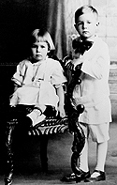 I'd come a long ways from the isolated iron town of Ishpeming, Michigan where I was born in 1912--the kind of place where our family owned our house but the mining company owned the land under it. I learned Swedish from my immigrant mother before I learned English.
(Right: Glenn Seaborg with his sister Jeanette.)
I'd come a long ways from the isolated iron town of Ishpeming, Michigan where I was born in 1912--the kind of place where our family owned our house but the mining company owned the land under it. I learned Swedish from my immigrant mother before I learned English.
(Right: Glenn Seaborg with his sister Jeanette.)
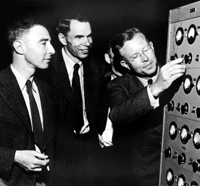 Graduate school at Berkeley was like a pilgrimage to scientific Mecca, the chemists and physicists there already legendary. I became friends with men such as future Nobel laureate Ernest O. Lawrence, who invented the atom-smashing cyclotron, and Robert Oppenheimer, whose brilliance would lead the Manhattan Project to success and whose arrogance would lead to his downfall. (Above Left: J. Robert Oppenheimer, Glenn Seaborg, and Ernest O. Lawrence, in early 1946 at the controls to the 184-inch cyclotron.)
Graduate school at Berkeley was like a pilgrimage to scientific Mecca, the chemists and physicists there already legendary. I became friends with men such as future Nobel laureate Ernest O. Lawrence, who invented the atom-smashing cyclotron, and Robert Oppenheimer, whose brilliance would lead the Manhattan Project to success and whose arrogance would lead to his downfall. (Above Left: J. Robert Oppenheimer, Glenn Seaborg, and Ernest O. Lawrence, in early 1946 at the controls to the 184-inch cyclotron.)
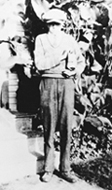 I'd been so shy as a boy that my mother arranged with my teachers to allow trips to the bathroom without asking because I was too bashful to raise my hand. Now surrounded by dazzlingly bright students, I was uncertain I could make the grade. But taking heart in Edison's dictum that genius is ninety-nine percent perspiration, I discovered a pedestrian secret of success. I could work harder than most of them. (Right: The young Glenn Seaborg.)
I'd been so shy as a boy that my mother arranged with my teachers to allow trips to the bathroom without asking because I was too bashful to raise my hand. Now surrounded by dazzlingly bright students, I was uncertain I could make the grade. But taking heart in Edison's dictum that genius is ninety-nine percent perspiration, I discovered a pedestrian secret of success. I could work harder than most of them. (Right: The young Glenn Seaborg.)
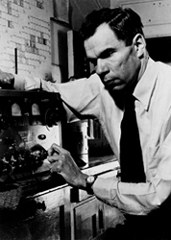 At age 28, I led the research team that discovered plutonium. We held back from announcing the discovery publicly when our tests revealed this element's special characteristic--harnessed in a then-hypothetical atomic bomb it would explode with inconceivable force. (Left: Seaborg at Geiger counter, circa 1941.)
At age 28, I led the research team that discovered plutonium. We held back from announcing the discovery publicly when our tests revealed this element's special characteristic--harnessed in a then-hypothetical atomic bomb it would explode with inconceivable force. (Left: Seaborg at Geiger counter, circa 1941.)
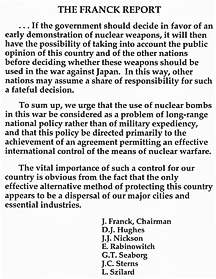 Three years of intense work produced just enough plutonium for two bombs--enough to end the war. On the 50th anniversary of the destruction of Hiroshima and Nagasaki, the media was full of moral debate about the bomb. During the war we were fighting for survival, motivated by fear of what would happen if the Axis powers developed it first. For years afterward, at family visits my cousins thanked me for saving their lives. They'd been stationed in the Pacific, readying for an invasion of Japan that they doubted they'd survive. The proposition that it might be immoral to end the war as quickly as possible did not occur to many of us. I had joined a committee of scientists who advocated the use of the atomic bomb for demonstration purposes. We hoped the enemy would see the destructive power of this weapon and immediately surrender. In June, 1945, we attempted to deliver our plan, the Franck Report, to President Truman. I don’t know if he ever saw our work. If he did, its recommendations were ignored. (Above Right: The Franck Report.)
Three years of intense work produced just enough plutonium for two bombs--enough to end the war. On the 50th anniversary of the destruction of Hiroshima and Nagasaki, the media was full of moral debate about the bomb. During the war we were fighting for survival, motivated by fear of what would happen if the Axis powers developed it first. For years afterward, at family visits my cousins thanked me for saving their lives. They'd been stationed in the Pacific, readying for an invasion of Japan that they doubted they'd survive. The proposition that it might be immoral to end the war as quickly as possible did not occur to many of us. I had joined a committee of scientists who advocated the use of the atomic bomb for demonstration purposes. We hoped the enemy would see the destructive power of this weapon and immediately surrender. In June, 1945, we attempted to deliver our plan, the Franck Report, to President Truman. I don’t know if he ever saw our work. If he did, its recommendations were ignored. (Above Right: The Franck Report.)
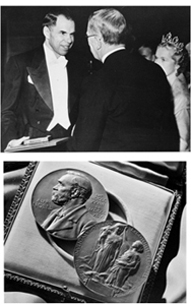 One November morning as I drove to work, the radio cackled with news of my reward for taking this chance--the 1951 Nobel Prize in chemistry shared with colleague Ed McMillan. At 39, I was one of the youngest winners ever of the world's most prestigious award. While the award is obviously coveted, some recipients have complained that the flood of speaking invitations and other demands that it brings ruined their research lives. Fortunately, I was able to avoid this pitfall, perhaps because my relative youth gave me the energy to continue my work amidst the flurry of attention.
One November morning as I drove to work, the radio cackled with news of my reward for taking this chance--the 1951 Nobel Prize in chemistry shared with colleague Ed McMillan. At 39, I was one of the youngest winners ever of the world's most prestigious award. While the award is obviously coveted, some recipients have complained that the flood of speaking invitations and other demands that it brings ruined their research lives. Fortunately, I was able to avoid this pitfall, perhaps because my relative youth gave me the energy to continue my work amidst the flurry of attention.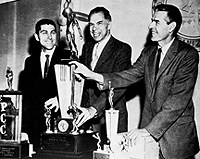 On the Berkeley campus, as the faculty athletic representative in the 1950s, I led what one writer called the "revolt of the intellectuals" against the excesses of big-time college sports. Widespread recruiting violations broke up our old intercollegiate athletic association, and I helped redraw the rules that led to the formation of what is now the Pac-10. Berkeley proved it was possible to combine athletic and academic excellence. Ranked third nationally in academics, our teams won a conference championship in football and a national championship in basketball. (Above: Left to right: Al Buch, Chancellor Glenn Seaborg and Coach Pete Newell upon their return from winning the NCAA Basketball Tournament.)
On the Berkeley campus, as the faculty athletic representative in the 1950s, I led what one writer called the "revolt of the intellectuals" against the excesses of big-time college sports. Widespread recruiting violations broke up our old intercollegiate athletic association, and I helped redraw the rules that led to the formation of what is now the Pac-10. Berkeley proved it was possible to combine athletic and academic excellence. Ranked third nationally in academics, our teams won a conference championship in football and a national championship in basketball. (Above: Left to right: Al Buch, Chancellor Glenn Seaborg and Coach Pete Newell upon their return from winning the NCAA Basketball Tournament.)
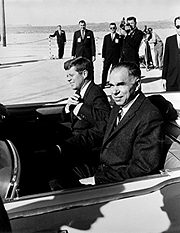 (Right: Seaborg with JFK.) That passion led to the treaty that banned testing of nuclear weapons in the atmosphere. Kennedy was so committed to this treaty that he told associates he would gladly forfeit his re-election for the sake of getting it passed.
(Right: Seaborg with JFK.) That passion led to the treaty that banned testing of nuclear weapons in the atmosphere. Kennedy was so committed to this treaty that he told associates he would gladly forfeit his re-election for the sake of getting it passed.
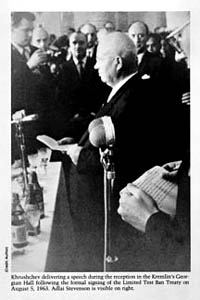 (Left: Soviet Premiere Khrushchev speaking; photo secretly taken by Glenn Seaborg.) My stature as a scientist gave me some latitude in diplomatic relations. I wanted to prove that science could provide a bridge between East and West, and regular meetings with Soviet scientists helped ease some of the tension and mutual mistrust. I found in trips to the Soviet Union that even at the height of the Cold War, Soviet citizens wanted to be friends with Americans. On one of these trips I became the first American official to meet with Leonid Brezhnev. Although he would take power in just a year and a half, few in the West had even heard the name. He gave me a message of peaceful intentions from Nikita Khrushchev to pass on to Kennedy.
(Left: Soviet Premiere Khrushchev speaking; photo secretly taken by Glenn Seaborg.) My stature as a scientist gave me some latitude in diplomatic relations. I wanted to prove that science could provide a bridge between East and West, and regular meetings with Soviet scientists helped ease some of the tension and mutual mistrust. I found in trips to the Soviet Union that even at the height of the Cold War, Soviet citizens wanted to be friends with Americans. On one of these trips I became the first American official to meet with Leonid Brezhnev. Although he would take power in just a year and a half, few in the West had even heard the name. He gave me a message of peaceful intentions from Nikita Khrushchev to pass on to Kennedy.
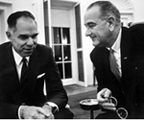 (Right: Seaborg with LBJ.) Kennedy's successor, Lyndon Johnson, was the most powerful and persuasive personality I ever met. He towered over others physically and emotionally, his exuberant presence filling the room. When he gave you his full attention, you felt surrounded.
(Right: Seaborg with LBJ.) Kennedy's successor, Lyndon Johnson, was the most powerful and persuasive personality I ever met. He towered over others physically and emotionally, his exuberant presence filling the room. When he gave you his full attention, you felt surrounded.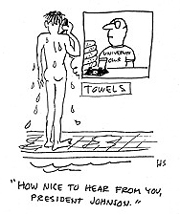
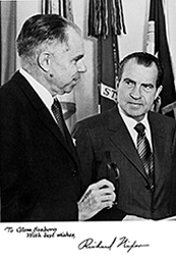 (Right: Seaborg and Nixon.) When Richard Nixon took office, I was one of a handful of incumbents he asked to stay on--almost all of them in scientific fields. I'd known Nixon since 1948, when we were both chosen among the U.S. Junior Chamber of Commerce's "Ten Outstanding Young Men." But I'd never supported him politically, and had likely even offended him by gracelessly refusing a joint photo opportunity when he visited my lab during his Senate campaign.
(Right: Seaborg and Nixon.) When Richard Nixon took office, I was one of a handful of incumbents he asked to stay on--almost all of them in scientific fields. I'd known Nixon since 1948, when we were both chosen among the U.S. Junior Chamber of Commerce's "Ten Outstanding Young Men." But I'd never supported him politically, and had likely even offended him by gracelessly refusing a joint photo opportunity when he visited my lab during his Senate campaign.
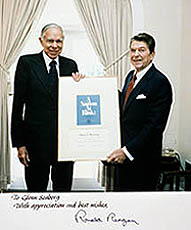 When the commission members refused to condemn America's educational problems in the strongest terms, I threatened to issue my own dissenting report. At last they relented, and our report began: "Our Nation is at risk....We have, in effect, been committing an act of unthinking, unilateral educational disarmament..." (Left: Seaborg and Reagan.)
When the commission members refused to condemn America's educational problems in the strongest terms, I threatened to issue my own dissenting report. At last they relented, and our report began: "Our Nation is at risk....We have, in effect, been committing an act of unthinking, unilateral educational disarmament..." (Left: Seaborg and Reagan.)
